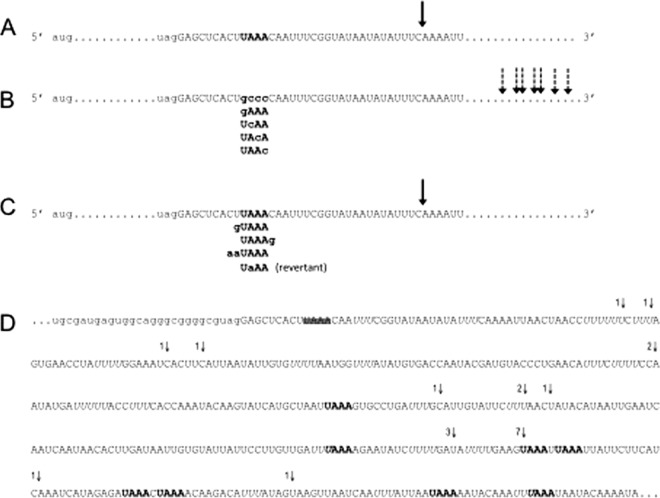Fig 3.
Schematic representation of the polyadenylation site in mRNAs derived from parental and mutant pcat plasmids. (A) Partial sequence of the 3′ UTR of cat transcripts from T. vaginalis cells that were transfected with the pcat-UAAA plasmid. The UAAA motif is in bold, and the arrow denotes the site at which all mRNAs were found to be polyadenylated. (B) Schematic representation of the 3′ UTR of cat transcripts from cells transfected with the different pcat mutant plasmids. In these plasmids, the UAAA motif was changed to the indicated sequences. The arrows represent the sites at which mRNAs were found to be polyadenylated (fully described in panel D). The mutated nucleotides are shown in bold lowercase letters. (C) Sequence of the 3′ UTR of cat transcripts from cells transfected with pcat mutant plasmids in which the UAAA motif remained unaltered but the adjacent bases were changed as indicated. The UaAA (revertant) is a revertant construct derived from pcat-UCAA by site-directed mutagenesis. The arrow denotes the site at which all the mRNAs analyzed were found to be polyadenylated and is the same position as in the wild type (A). The mutated nucleotides are shown in bold lowercase letters. (D) RNA sequence from the pcat mutant plasmids in panel B, showing the actual positions where mRNAs were found to be polyadenylated. Part of the cat coding sequence is in lowercase letters. The 3′ region is in uppercase. The parental UAAA motif is not present in the pcat mutant plasmids and is therefore crossed out; this tetranucleotide was replaced by the bold motifs depicted in panel B. The last nucleotides identified before the poly(A) tail in cat cDNA clones are identified by arrows. The number of clones found for each position is shown next to the vertical arrows. Additional UAAA motifs in the 3′ noncoding region are shown in bold, and U-rich elements are in italic. In all cases, the sites where the mRNAs were polyadenylated were deduced from sequencing oligo(dT)-derived cDNA clones.

